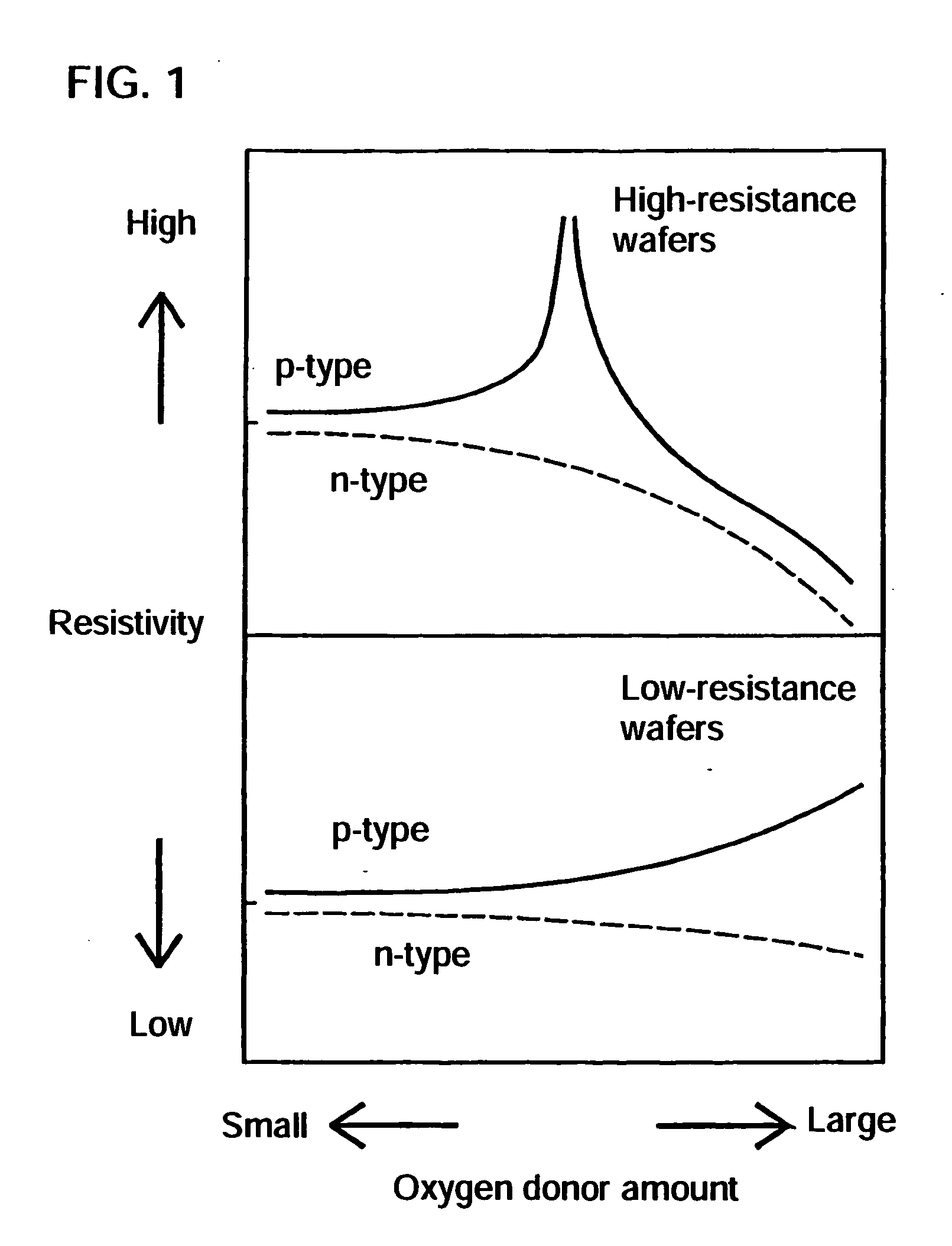Process for producing high-resistance silicon wafers and process for producing epitaxial wafers and soi wafers (as amended)
a technology of high-resistance silicon and epitaxial wafers, which is applied in the direction of crystal growth process, after-treatment details, under a protective fluid, etc., can solve the problems of high cost of cmos circuit design, and high cost of rf-cmos circuit production, etc., to achieve the effect of reducing production costs
- Summary
- Abstract
- Description
- Claims
- Application Information
AI Technical Summary
Benefits of technology
Problems solved by technology
Method used
Image
Examples
example 1
[0132] For confirming the effects of the present invention, a crystal grown by the CZ method was processed into 8-inch p-type wafers having a resistivity of 2000 Ωcm, an initial interstitial oxygen concentration of 10 to 15×1017 atoms / cm3 (ASTM F 121-1979) and, further, a carbon concentration of 5×1016 atoms / cm3 (ASTM F 123-1981), and subwafers were prepared by subjecting the wafers to 1 hour of donor killer heat treatment at 650° C.
[0133] The subwafers prepared were subjected to first heat treatment, namely 1 hour of heat treatment at 900° C., following wafer charging in a furnace at a temperature of 700° C. and heating up at a rate of 1° C. / minute, using a N2 (containing 3% O2) gas atmosphere. Then, heat treatment was carried out, as second heat treatment, at 1200° C. for 1 hour using an Ar gas atmosphere. The temperature was then lowered to 1000° C., and heat treatment was carried out at that temperature for 10 hours.
[0134] The wafers obtained after the above heat treatment pro...
example 2
[0136] For confirming the effects of using wafers having a relatively high initial interstitial oxygen concentration, subwafers having a resistivity of 2000 Ωcm, an initial interstitial oxygen concentration of 13 to 15×1017 atoms / cm3 (ASTM F 121-1979) and, further, a carbon concentration of 5×1016 atoms / cm3 (ASTM F 123-1981) were prepared in the same manner as in Example 1 by carrying out donor killer heat treatment at 650° C. for 1 hour.
[0137] They were subjected to first heat treatment under the same conditions as in Example 1 and then to second heat treatment, namely 1 hour of heat treatment at 1200° C. in an Ar gas atmosphere and thereafter immediately discharged out of the furnace at 600° C. without subjecting to medium temperature treatment. The wafers obtained were subjected to silicon epitaxial growth treatment in a horizontal single wafer processing type growth furnace under the same conditions as in Example 1.
[0138] The epitaxial wafers obtained were examined for oxygen ...
example 3
[0139] Silicon wafers were produced in the same manner as in Example 1 by preparing 8-inch p-type subwafers having a resistivity of 2000 Ωcm, an initial interstitial oxygen concentration of 10 to 15×1017 atoms / cm3 (ASTM F 121-1979) and, further, a carbon concentration of 5×1016 atoms / cm3 (ASTM F 123-1981) and further subjecting them to first heat treatment and second heat treatment under the same conditions.
[0140] Using the thus-produced silicon wafers, oxygen ions were implanted into them from the front surface side at an acceleration voltage of 100 keV These wafers were placed in a heat treatment furnace maintained at 700° C., then heated to 1320° C. and maintained at that temperature for 10 hours. Thereafter, the wafers were cooled to 700° C. and discharged out of the furnace. SIMOX wafers were thus produced.
[0141] The SIMOX type SOI wafers obtained were subjected to 1 hour of heat treatment at 400° C. in an atmosphere of N2 (containing 3% O2) in a simulation of the heat treatm...
PUM
 Login to View More
Login to View More Abstract
Description
Claims
Application Information
 Login to View More
Login to View More - R&D
- Intellectual Property
- Life Sciences
- Materials
- Tech Scout
- Unparalleled Data Quality
- Higher Quality Content
- 60% Fewer Hallucinations
Browse by: Latest US Patents, China's latest patents, Technical Efficacy Thesaurus, Application Domain, Technology Topic, Popular Technical Reports.
© 2025 PatSnap. All rights reserved.Legal|Privacy policy|Modern Slavery Act Transparency Statement|Sitemap|About US| Contact US: help@patsnap.com



